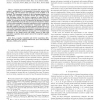Free Online Productivity Tools
i2Speak
i2Symbol
i2OCR
iTex2Img
iWeb2Print
iWeb2Shot
i2Type
iPdf2Split
iPdf2Merge
i2Bopomofo
i2Arabic
i2Style
i2Image
i2PDF
iLatex2Rtf
Sci2ools
CORR
2007
Springer
2007
Springer
Capacity Gain from Two-Transmitter and Two-Receiver Cooperation
Abstract—Capacity improvement from transmitter and receiver cooperation is investigated in a two-transmitter, two-receiver network with phase fading and full channel state information (CSI) available at all terminals. The transmitters cooperate by first exchanging messages over an orthogonal transmitter cooperation channel, then encoding jointly with dirty-paper coding. The receivers cooperate by using Wyner–Ziv compress-and-forward over an analogous orthogonal receiver cooperation channel. To account for the cost of cooperation, the allocation of network power and bandwidth among the data and cooperation channels is studied. It is shown that transmitter cooperation outperforms receiver cooperation and improves capacity over noncooperative transmission under most operating conditions when the cooperation channel is strong. However, a weak cooperation channel limits the transmitter cooperation rate; in this case, receiver cooperation is more advantageous. Transmitter-and-receiver c...
| Added | 13 Dec 2010 |
| Updated | 13 Dec 2010 |
| Type | Journal |
| Year | 2007 |
| Where | CORR |
| Authors | Chris T. K. Ng, Nihar Jindal, Andrea J. Goldsmith, Urbashi Mitra |
Comments (0)

